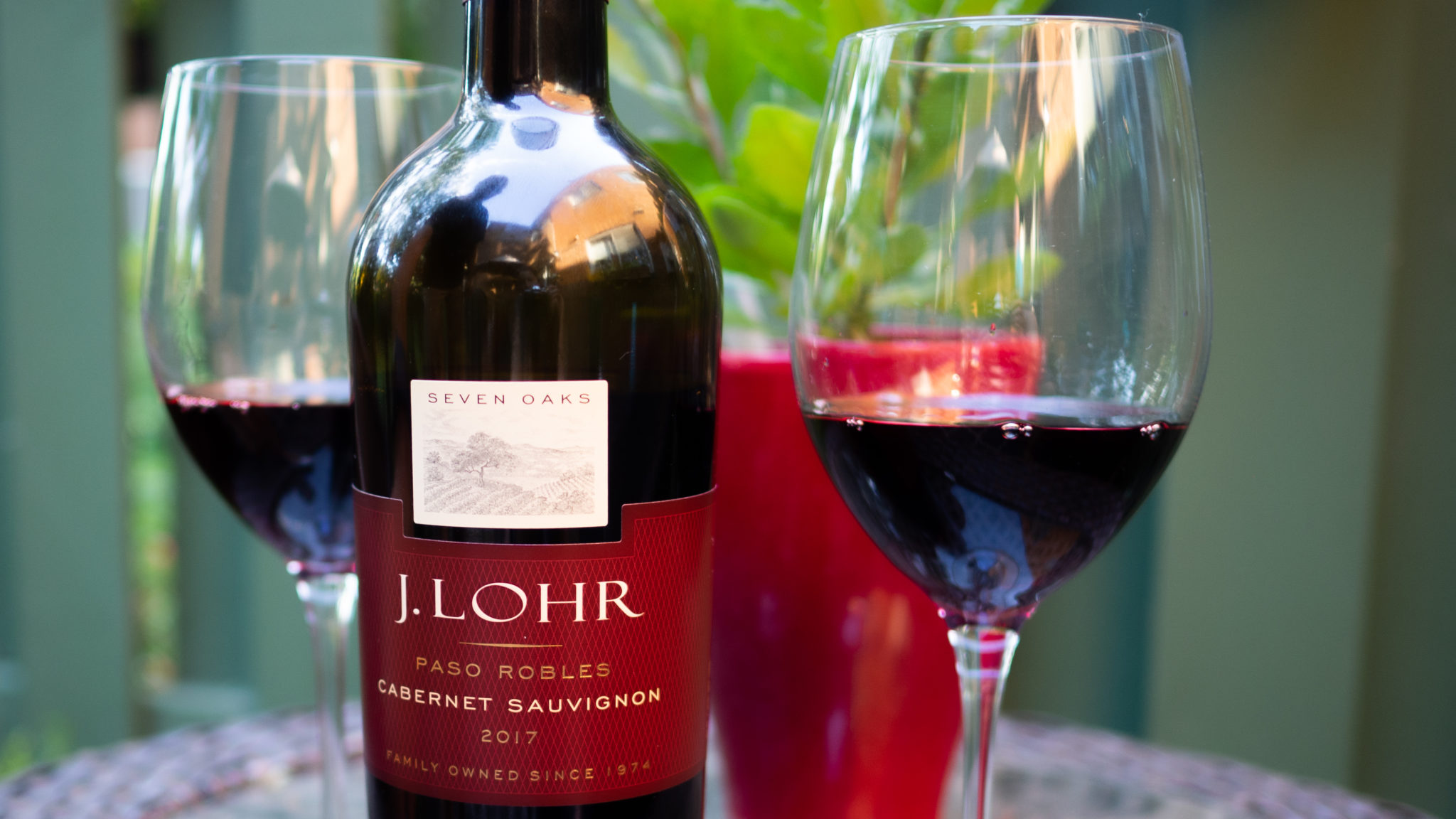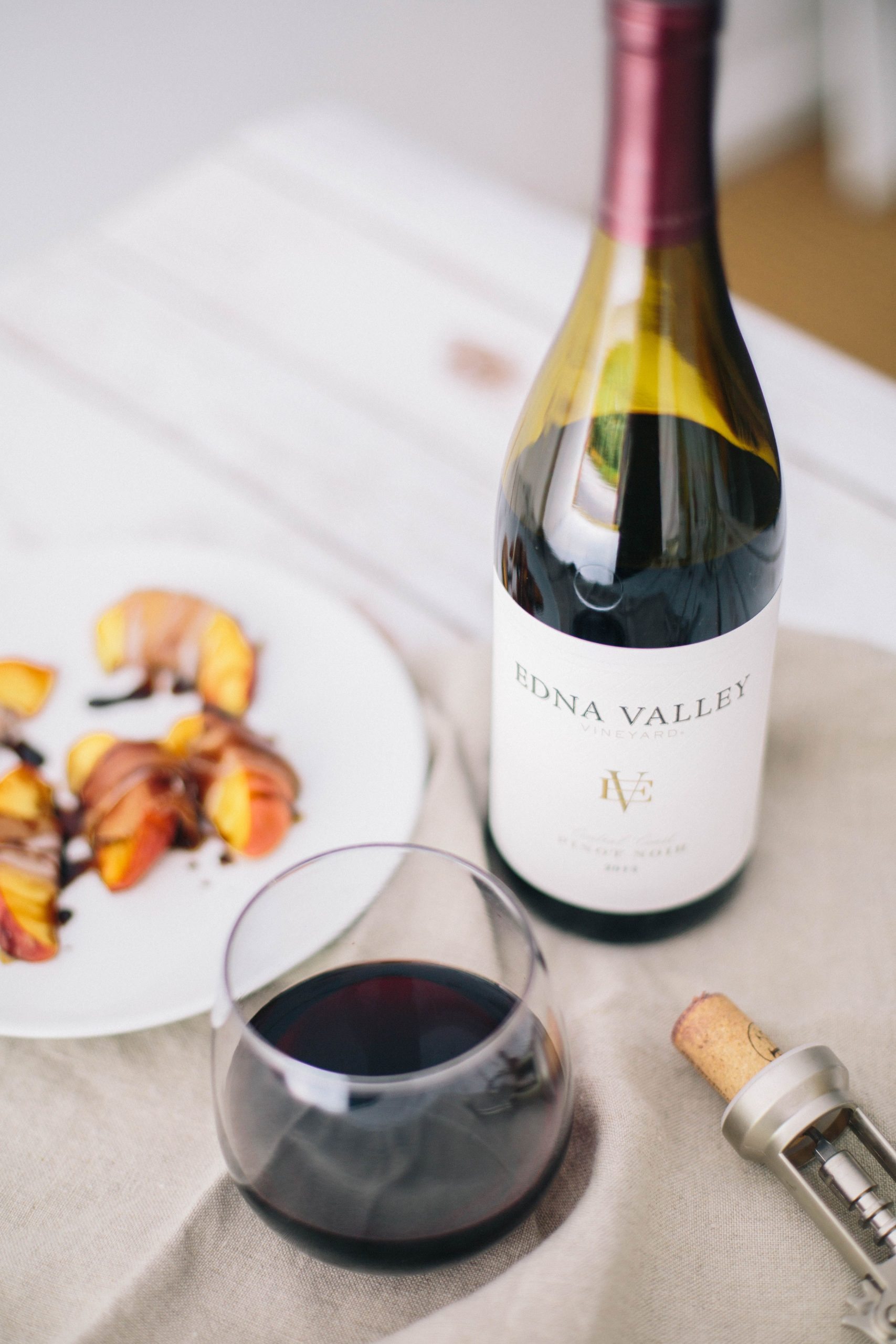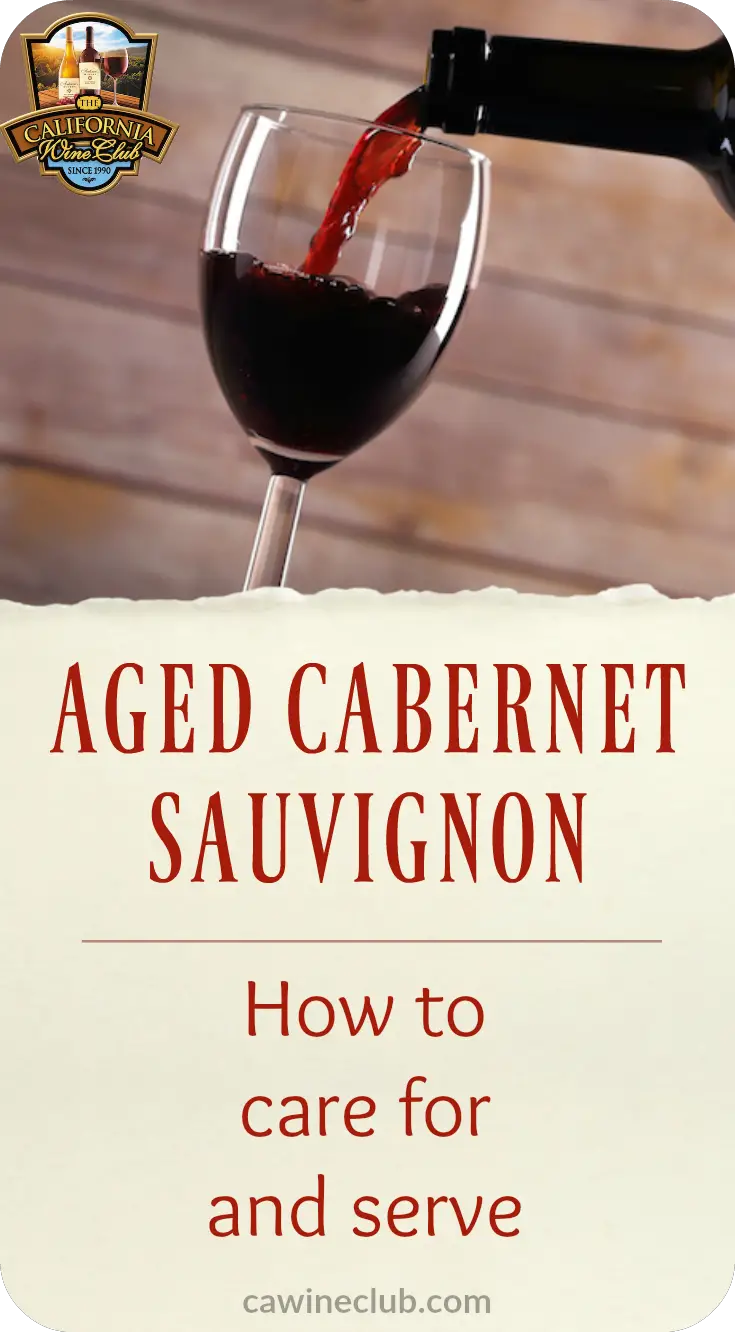Etiquette For Drinking Cabernet Sauvignon
Drink Cabernet Sauvignon in red wine glasses. Hold the glass by its stem to avoid warming the wine with your hand.
Drink it in small sips. Aged and bold Cabernet Sauvignon is often a meditation wine. Thus, a glass should last between 15 and 30 minutes. Never drink shots.
Never add ice to Cabernet Sauvignon. First, ice waters down the wine and its bouquet. Furthermore, ice is usually added to low-quality or cheap beverages. Thus, adding ice can be seen as an offense to the quality of the wine, and therefore to your host.
The Best Serving Temperature For Cabernet Sauvignon
An old adage says that you should generally serve red wines at room temperature, the same goes for Cabernet. However, room temperature, while being a good starting point, is entirely relative. Serving wine in a beach villa would be a very different thing than serving it during wintertime in Alaska. Generally speaking, the best temperature for drink your red wine depends on the type of red wine.
In the case of the Cabernet Sauvignon, although warmer is better, the ideal temperature for this full-bodied red is 60 degrees Fahrenheit . If you properly stored the Cabernet, this means you need to warm it up a bit leaving it at the so bandied-around room temperature for several minutes. On the other hand, if you stored the Cabernet at room temperature, you will need to cool it slightly by refrigerating it for 30 minutes. To maintain the temperature of the wine as you drink it, hold the glass by the stem.
The ultimate answer to the question Should you chill Cabernet Sauvignon? will depend mostly on preference and previous storage temperatures. If you stored it cool at the right temperatures, then you need to warm it slightly, if it is the other way around you chill it. Thus, the mystery is resolved! Lets enjoy the wonderful flavor found in this incredible red wine to the fullest.
Varying Preferences For Serving Temperature
The temperature that you should serve any wine all depends on the climate that you are located in. Your wine is naturally going to come closer to the temperature surrounding it. The warmer the climate, the faster the temperature is going to rise.
For example, I live in Hawaii, which is well known for its warm, tropical climate. When dining outdoors, I serve Cabernet Sauvignon a bit cooler because in a matter of minutes the wines temperature will rise by 5-10 degrees. Despite weather challenges, you still want your wine bottle to stay at a slightly cooler temperature.
Pro Tip for Slow Sippers in a Hot Climate: Place your bottle in an ice bucket with just a few ice cubes and no water. Re-cork it and slowly and tilt it upside down a couple of times to even out the temperature before serving.
Also Check: Does Total Wine Offer Military Discount
Cab’s Best Serving Temperature
While many people believe that room temperature is ideal for serving red wines, this is actually a myth. Red wines flower into full flavor at a temperature that is slightly cooler than room temperature–so very slightly chilled. For full-bodied reds, like cabernet sauvignon, the ideal serving temperature is 60°F , although the wine’s flavors will present well anywhere between 55 -65°F . For wine that has been properly stored, this means you need to warm it up slightly after removing it from the wine fridge by leaving it at room temperature for about 30 minutes. If the wine has been stored at room temperature, you will need to chill it slightly by refrigerating it for 30 minutes.
So What Is The Optimal Serving Temperature For Cabernet Sauvignon

Cabernet Sauvignons should be served at a temperature range of 60-65F, which is considered slightly chilled. This is cool enough to mute the smell of alcohol, without masking any of those gorgeous aromas that Cabernet Sauvignon has to offer. When alcohol is served too warm, it tends to coat the inside of the mouth, making it difficult for those silky smooth tannins to shine.
You might think all wine is the same , but the reality is that each wine has a different texture. And, the texture experience shifts according to the temperature it is served at. This is very important when it comes to pairing with food.
Recommended Reading: Where Can I Buy Jamaican Red Label Wine
Where Does Cabernet Sauvignon Wine Come From
Cabernet Sauvignon is produced in a huge range of countries and wine regions. Fortunately, Cab is also well-suited to a relatively broad range of micro-climates and terroirs, which means that growers and producers around the world have found success with it. There are, of course, certain standout regions for Cabernet Sauvignon, and no two are more well-known than Napa Valley and Bordeaux. In Napa, producers leverage warmth and abundant sunshine to create Cabs of power, generosity, ripe fruit, and depth. Many of the top California Cabs are varietally labeled, meaning that only Cabernet Sauvignon appears on the bottle .
Many of the most prized cult wines of Napa, like Harlan Estate, Screaming Eagle, and more, are built on a backbone of Cabernet Sauvignon. For some consumers, names like Silver Oak, Caymus, Alpha Omega, and others are inextricably linked to their primary grape variety. In Bordeaux, especially on its Left Bank, Cab is often used as the main component in blends, typically alongside some combination of Merlot, Cabernet Franc, Petit Verdot, and Malbec. Château Lafite-Rothschild, Château Mouton-Rothschild, and more are dominated by the grape variety.
What Are The Best Wine Regions For Cabernet Sauvignon
As mentioned previously, Cabernet Sauvignon is grown in most major wine-growing regions. In fact, only Antarctica does not have any. So, you have a lot of regions to look for a style of Cabernet Sauvignon you enjoy.
The wine region with the highest recognition for its Cabernet Sauvignon in the Old World includes the Left Bank in Bordeaux, Tuscany, Italy .
When you are considering the New World, look for Napa in California, the Maipo region of Chile, the Margaret River in southern Australia, and the Columbia Valley in Washington State.
Recommended Reading: Do They Still Sell Wine Coolers
Storing Organic Cabernet Sauvignon
In common with all organic wines, Cabernet Sauvignon likes to be stored in a cool spot, away from direct sunlight and vibrations. If the wine is sealed with a cork, the bottle should be stored horizontally, so that the cork remains moist, thus preventing it from drying out.
You can read more about how to store organic wine on our website.
Step : Serve Your Cabernet At The Optimal Temperature
Cabernet Sauvignon is a full-bodied, red wine. Its important that this type of wine isnt served too warm or the alcohol can overwhelm the wine and the structure will be out of balance. This type of wine should be served at 59-64 degrees Fahrenheit . This is much cooler than our typical room temperatures and much warmer than our refrigerators.
So, whats the best way to obtain that perfect serving temperature without harming the Cabernet? Just place it in the refrigerator for 45 minutes prior to decanting. This accounts for the warm-up time that will happen while the wine is decanting.
Recommended Reading: Can I Ship Wine Through Fedex
What Does Cabernet Sauvignon Taste Like
Cabernet Sauvignon is a full-bodied dark red wine. Its flavor profile varies widely and can range from notes of black pepper to sweet strawberries. There are over 3,500 varieties of Cab so the flavors of each bottle can be different based on many factors. Cabs can have any of the following flavor:
- Black currant
According to the Masterclass article, Cabernet Sauvignon tastes like green bell peppers. That flavor comes from pyrazine. This chemical compound is found in the skin of the grape and some varieties have more pyrazine than others so the intensity of this flavor can vary.
So after you take a sip, ask yourself, what does this Cabernet Sauvignon taste like? You should be able to taste a variety of flavors!
Short Term Vs Long Term Aging
Cabernet Sauvignons are famous for being able to age for years before reaching their prime drinking peak. A great way to know exactly how long you should cellar a wine is by looking at the facts of the vintage. Vintages are known to make or break cellar sleepers.
A website that every wine lover should explore is Vivino.com. Vivino allows you to search your wine and learn everything you need to know about it! Not only does it give you the history of your bottles vintage, but also lists vintage comparisons and recommended storage time.
Don’t Miss: How Can I Make Wine At Home
Food & Aromas To Pair Cabernet Sauvignon With
The ideal food pairings depend on the variety of Cabernet Sauvignon, and on its body and aromatic profile.
In general, Cabernet Sauvignon pairs well with strong flavors.
Pair it with strong cheese. Such as Cheddar or Gorgonzola. Accompany it with flavor-rich courses. Such as venison meat, meat stews, grilled tuna, and strong sauces.
Avoid pairing Cabernet Sauvignon with light and delicate foods, as it will cover their flavor.
Store Your Wine Bottles Lying Down

How wine bottles are stored is vital to their longevity. Store Cabernet Sauvignon bottles on their sides to ensure the wine rests against its cork. This practice creates a liquid barrier between the wine and the cork and helps to prevent the cork from drying out. Aging wine in a location with a consistent humidity of 50-80 percent will also help to keep the corks inside resting bottles from becoming too dry.
Read Also: What Is The Best Red Wine For Beginners
Other Old World Producers
The introduction of Cabernet Sauvignon to Spain occurred in the Rioja region when the planted cuttings from Bordeaux in the nineteenth century. It was not until the 1960s, however, before cultivation took off. By 2015, it was the sixth most widely planted red wine grape in Spain. Today it is permitted in about half of the Spanish DOPs . The grape is most prominent in the Catalan wine region of Penedès, where its use was revived by the estates of Bodegas Torres and Jean León. There the grape is often blended with Tempranillo. It is also primarily a blending grape in the Ribera del Duero, but producers in Navarra have found some international acclaim for their varietal wines.
Oshaughnessy 2018 Cabernet Sauvignon
This is such an outstanding wine at any price, but here were talking about outstanding value as well. Notes of iron and crushed rock lead to a lengthy balance of juicy red fruit and clove.
With small amounts of Merlot, Malbec, Saint-Macaire, and Cabernet Franc, it shows a deft hand at blending with lasting notes of black pepper and nuanced oak. Editors Choice.Virginie Boone.
Don’t Miss: Where To Buy Conundrum Wine
Maintaining Cabernet Sauvignon Temperature
As you drink the wine, it will warm slightly, causing subtle changes to the wine’s character. To maintain the temperature of the wine as you drink it in order to allow it to warm to room temperature more slowly, hold the wine glass by the stem. When you hold the wine glass by the bowl, your hand warms the wine more rapidly.
Cabernet Sauvignon Vs Merlot Vs Pinot Noir Vs Malbec
People find it difficult to differentiate between Cabernet Sauvignon vs Merlot because they are the two of the most common red wine varietals in the US. But, they are different. Merlot has a softer flavor, is slightly less acidic, and has fewer tannins. It also has a slightly fruitier flavor and is more delicate.
Pinot Noir vs Cabernet Sauvignon: When it comes to Pinot Noir, Pinot Noir is a thin and elegant wine that grows in fewer regions. Also, they are grown in different climates and have different harvesting periods. Pinot is harvested first and is grown in colder climates, while cab sav develops better in warmer climates, and is harvested later.
Malbec vs Cabernet Sauvignon: Malbec is yet another wine that is often compared with Cabernet Sauv. The cabernet tasting notes of Malbec vary significantly by region, whereas Cabernet has a consistent taste. Also, cabernet sauvignon wine is light-bodied and has fewer tannins as compared to Malbec.
You May Like: Don Julio 1942 Pa Wine And Spirits
What Makes Cabernet Sauvignon Special
Cabernet Sauvignon berries are extremely small. They say good things come in small packages and this is true when it comes to fruit. The small berries flavors become super concentrated, gain refined textures and complex aromatics as they ripen.
The vines are slow to ripen, allowing the vineyard managers to harvest them later in the season. This is a positive and a negative, as waiting too long can lead to a potential for hazardous weather conditions.
In addition to its fame in Bordeaux, France, Cabernet Sauvignon is currently harvested in every major wine-growing region. It is found as both a single varietal wine and as a blend. This is not by sheer chance. Cabernet Sauvignons small berries are pretty resilient.
Although the vine prefers warmer climates, it is capable of surviving through a multitude of poor weather conditions, pests, and diseases. Another aspect of the grape loved by its producers is its ability to age.
Cabernet Sauvignon grapes contain many tannins. This can be difficult for some drinkers to swallow, but thanks to its affinity for oak, these tannins are tamed during fermentation and aging.
The marriage of Cabernet Sauvignon and oak make it ideal for assembling a wine that is not only age-worthy but provides structure to the wines it is blended with.
How To Store Your Bottle After Youve Popped The Cork
The best place to store an already opened bottle of vino is in your refrigerator. Typically, an opened bottle of Cabernet has a shelf life of about 3 days before the oxygen gets the best of it. Storing it in the fridge will actually prolong the shelf life to about 5 days, thanks to the lower temperature that helps to slow down the oxidation process.
Another great way to keep your Cabernet Sauvignon drinkable for at least another week is to use WineSave. This little miracle worker is simply Argon gas inside of a bottle, that comes with a little rubber nozzle. All you have to do is place the nozzle into your bottle, give it a spray, and then quickly cork your bottle. The Argon gas will sit on top of the surface of the wine, protecting it from oxygen exposure. Inexpensive and effective what more could you ask for?
Whether youre new to Cabernet Sauvignon or youre a long-time lover, its always worth ensuring that you experience all that it has to offer. After all, it is truly one special grape variety. Just dont forget to enjoy it with good food and great company.
Cheers!
Katarina Jelks is a professionally trained sommelier from Hawaii. She received her Wine & Management Diploma from Le Cordon Bleu in Paris. Her experience working across the wine industry, in locations all around the world , has resulted in a global perspective. She loves sharing her passion with others and helping them to chase their thirst for interesting wine and great food.
You May Like: Can Wine Cause Kidney Stones
Alternatives For Cabernet Sauvignon
Classic Cabernet Sauvignon is close to almost every red wine lover. It gets so much love that it was recently declared the worlds most planted wine grape variety. Despite being so famous, finding an inexpensive bottle is not easy. So to expand your palate, let us take a look at some wines similar to Cabernet Sauvignon.
Is It Okay To Drink Cabernet Sauvignon With Ice

The general rule for drinking wine is if you like it, drink it. Do not let anyone tell you how to enjoy wine. With that being said, thanks to its thick skins, Cabernet Sauvignon is a highly tannic wine.
The tannins are responsible for the drying sensation in your mouth. When a wine is cold, the perception of tannins is higher, so you will feel like the wine is actually drier than it is.
Read Also: Where To Buy Wine Online Usa
How To Store Cabernet Sauvignon
Store Cabernet Sauvignon in a cool place. Keep the bottle away from direct light. Either natural or artificial. Store the bottle far from any source of heat. You can store Cabernet Sauvignon in your cellar for over 10 years.
Place the bottle in a horizontal position, to keep the cork moist. Dry corks might let the oxygen in and spoil the wine.
Do not store it in the fridge or in the freezer.
What To Look For
This is where people start to get nervous. Dont worry! Its easier than you think check out this primer on wine tasting. So what should you find in a good Cabernet Sauvignon? Lots of juicy red and black fruits, like strawberries, cherries, and currants. Try to imagine the scent of a strawberry , and then smell and taste your wine. It should be much easier to pick out that flavor now. Cabernet Sauvignon can also be quite tannic, or drying to your mouth, especially with less expensive bottles. Look for one thats balanced, and doesnt leave you feeling like the Sahara.
Don’t Miss: Wine Store Naples Fl
Popular Blends Of Cabernet Sauvignon
Cabernet Sauvignon grapes are popular partners for blending in varietal wines. Bordeaux produces some of the popular blends like Merlot and Cabernet Sauvignon in different proportions. Malbec is yet another Cabernet Sauvignon blend known for wine with creamy, plummy, and fruit flavors. Some other popular blends of Cabernet Sauvignon from this region are Sangiovese, Carménère, Petit Verdot, Tempranillo, Zinfandel, Cabernet Franc and Syrah .
Popular Cabernet blend from some other regions is Washingtons CMS Blend , Portugals Douro Tinto Blend, Greeces Rapsani Blend, and Italys Super Tuscan Blend .